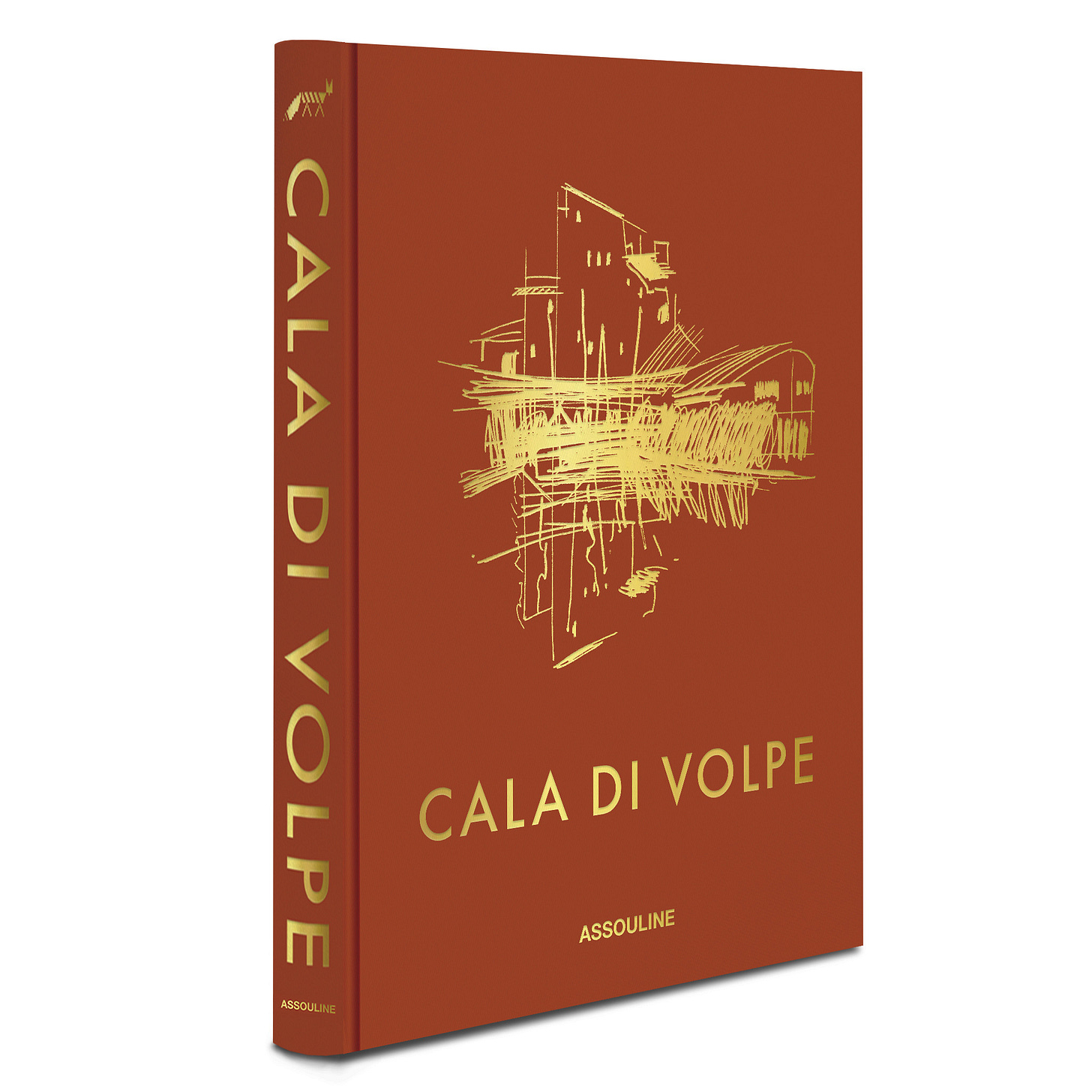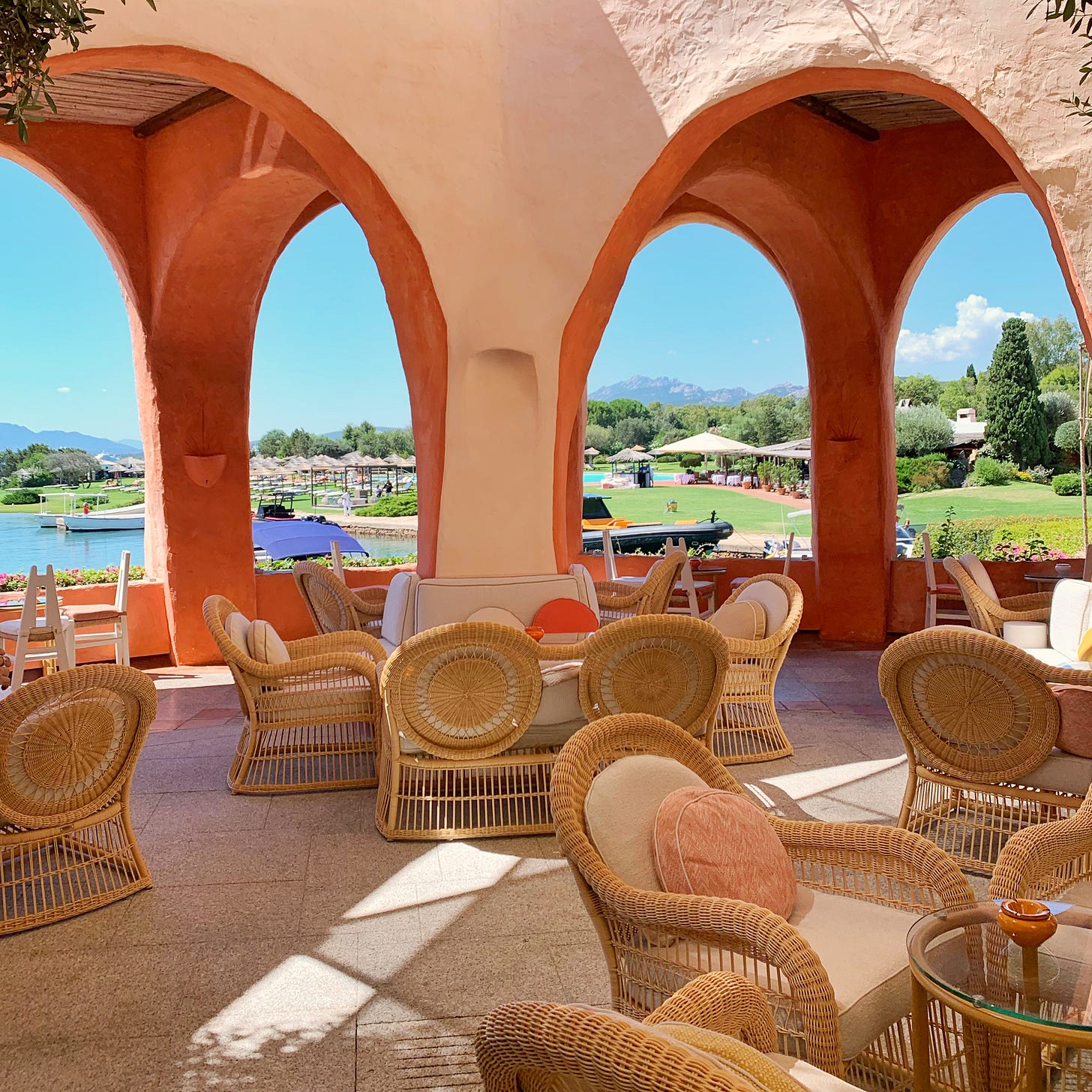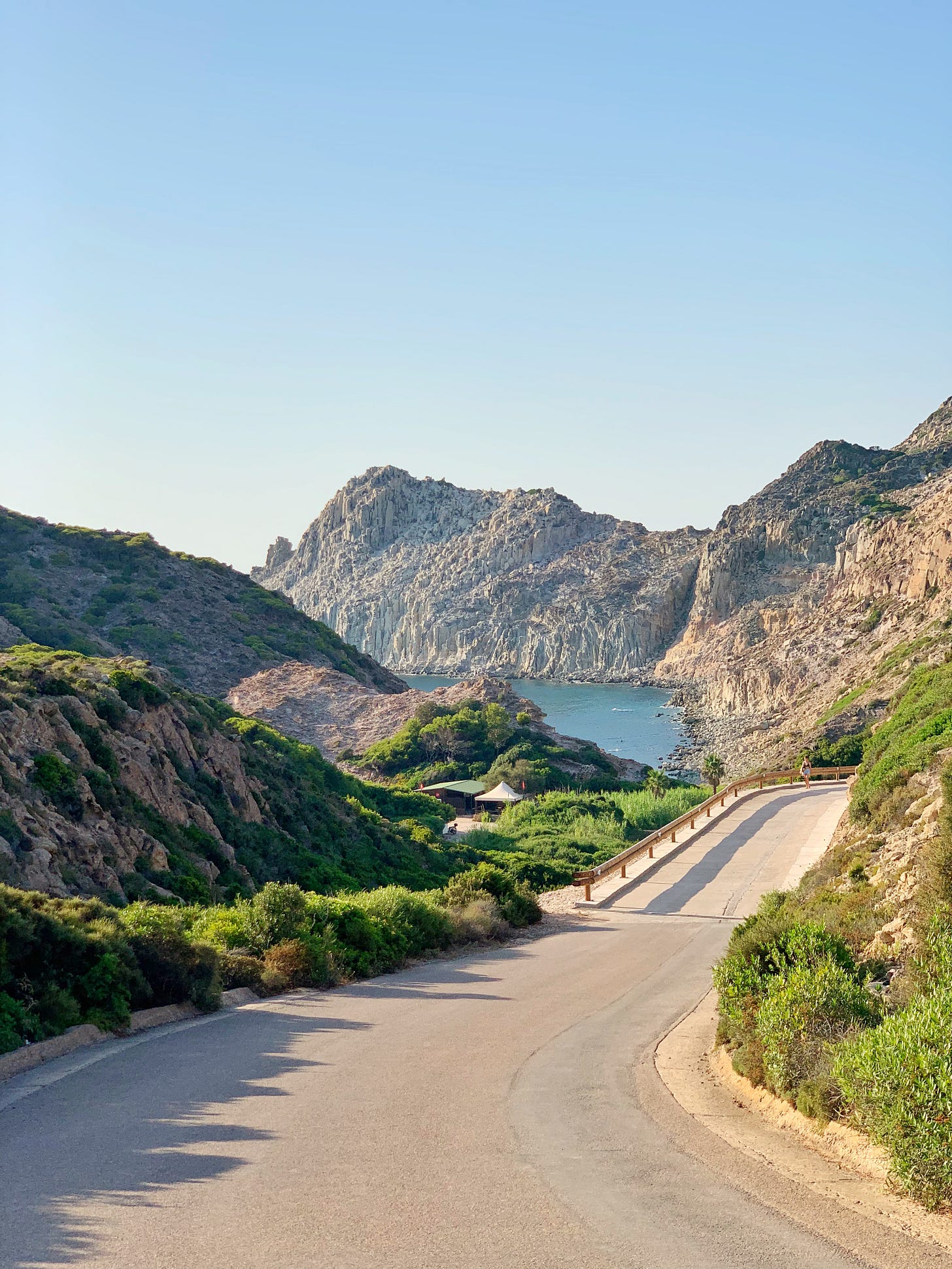Meet Nicky Swallow, Author of a New Book About Hotel Cala di Volpe on Sardinia's Glamorous Costa Smeralda
Issue #43
An esteemed journalist who writes for Condé Nast Traveller, the Telegraph, and the Independent, among other outlets, London-born Nicky Swallow has been living in Florence since 1981. Formerly a professional musician, she moved to Florence to play viola in the opera orchestra for three months and never left. She currently splits her time between travel writing and running La Foce music festival in Tuscany.
I met Nicky on a press trip at the beautiful Borgo Santo Pietro resort in Tuscany a couple of years ago, but I’ve known her byline for much longer. On the eve of her debut book, Cala di Volpe, a gorgeous photo-heavy tome about the iconic hotel on Sardinia’s glamorous Costa Smeralda published by Assouline, I called her to chat about Sardinia. I’m thrilled to share her insights about the island as part of my series of interviews with creatives and entrepreneurs in Italy.
Today I thought we would stay focused on Sardinia, since that is the topic of your book and perhaps one day we’ll talk more about Florence and Tuscany. So how did this project come about?
I got a message on Instagram from an editor at Assouline who asked me if I'd be interested in collaborating on a project they had in mind and of course I said yes. Then they wrote and told me that Cala di Volpe is celebrating 60 years of business this year and they had commissioned a book about the hotel and were looking for somebody to write it.
Was that your first book?
Yes, and in fact I said yes rather reluctantly because it’s a big project. It was more words than I've ever written about any one thing. It’s about 6,000 words and I was kind of worried about whether I'd actually be able to produce that many words about a single hotel. But then I thought, “This is stupid, I can’t possibly say no,” because it’s Assouline, which is a very prestigious publisher. And I asked a friend who’s in the business and he said, “Look, you’ve got nothing to lose. If you write the book and they don’t like it, you haven’t lost anything,” which is quite true, so I decided to go for it.
I was just reading my advance copy and I thought you did a lovely job of describing the hotel, but could you explain for those who don’t know the hotel, why is it so iconic?
As I said, it opened in 1963. This is its 60th anniversary. But in a wider context, it was part of the project of the Costa Smeralda, which was the brainchild of the Aga Khan, who was an Ismaili prince with a long, noble aristocratic family history and he had this dream. Legend has it that he was on his yacht and he sailed past this stretch of virgin coast on the northeastern corner of Sardinia and thought “I must have this,” but actually the reality is that he was brought there by a business associate who thought he might be interested in a business project there.
So he saw it and fell in love with the fact that it was just totally unspoiled. It was wild, there were no roads, there was no running water, there were a few stone cottages, shepherd’s huts, there were sheep but very few people around. There was nobody on the coast and even the inland villages were pretty sparsely populated.
And so he set up a consortium made up of interested business partners and his dream was to develop that stretch of coast making as little environmental impact as possible, so it was actually an extremely prophetic project that he had in mind and he was way, way, way ahead of his time in terms of his philosophy about sustainability.
So it’s thanks to him that the Costa Smeralda project took shape and they employed various architects, including a very famous French architect called Jacques Couëlle, who was already very well established at the time, to build a series of hotels. There were four hotels originally and then there were other buildings. They built the port of Porto Cervo and so on.
But Cala di Volpe was the very first hotel on the Costa Smeralda to be built and to start with it was quite a modest place. It was really very much what we would now call shabby chic or barefoot chic. The idea was he had lots of very wealthy and well connected friends and royalty and they all flocked to Sardinia to this place he set up where they could dress casually and relax and it was a very easy lifestyle situation. And that has changed a bit now, but that was the idea in the first place.
Did you learn any fun tidbits about the hotel while you were working on this book?
Everybody who is anybody has been to this hotel. Film stars, rock stars, princes and princesses, oligarchs—everybody has been there. Princess Diana and Dodi Fayed had their last lunch in Italy there before flying to Paris and dying in the tunnel. And so there were many, many stories. It's the sort of place that if walls could speak, you'd have a lifetime of stories.
But I wasn't allowed to talk about any of that. One of the things they pride themselves on is their discretion and they wouldn’t allow me to mention any names at all in the book. Then we found some stuff that had already been published, some of their guests who have written about it and said what the Cala di Volpe meant to them, and so there were some stories that we were able to put into the book.
I did get to speak to the staff and the barman and the chef and I managed to get some stories out of them and that was interesting. And I saw things like on my first day there, there was a guy walking around with a bucket of white paint and a paintbrush and I asked him what he was doing and he said that’s what he does. He touches up the walls. That’s what he does all day everyday. He walks around all the rooms and the public spaces with a pot of white paint and a paintbrush touching up the paintwork.
It certainly is very pristine and maintained in that chic barefoot style. I stopped by last summer. You were there in the fall, right?
I was there in October.
My husband and I went to Sardinia last year and we didn’t stay there because it was peak season, but we toured the hotels and had lunch at Romazzino, one of the other hotels. And while I was planning that trip, I read your article about the best hotels in Sardinia for Condé Nast Traveller. So I was curious to know, how many times have you been to Sardinia?
Years and years ago I wrote a sort of pocket guidebook to the Costa Smeralda and then hadn’t been back for a long time, but I followed the hotel openings and so on. So I haven't actually been that much to the Costa Smeralda, I have to confess, but I have been to western Sardinia because I have a friend who has a house there. So my main experience in Sardinia is the west coast, which is wild and unkempt and totally different from the Costa Smeralda.
So what are your favorite places in Sardinia?
The west coast, they call it Costa Verde, and it’s totally different. It’s really wild. Actually there are a couple of more upmarket places. One is Alghero and the other one is Bosa, which is between Alghero and Oristano, and that’s a very pretty little town with lots of colored buildings. There are gorgeous beaches around Alghero and then you go further south and there’s this provincial town called Oristano and then south of that there’s a series of incredibly wild beaches with very little in the way of hotels.
There’s a hotel called Le Dune. It’s on a beach called Piscinas, which is an extraordinary beach south of Oristano, and it’s reopened this season. It’s the only hotel of any note at all. And then you go down to Isola di San Pietro, which is beautiful. It’s very pretty but very wild. I think most people head to the Costa Smeralda or they go down to Cagliari, but they don’t go to the west.
We actually went to the Isola di San Pietro and spent some time in Carloforte and loved it. The beaches there are lovely. They’re very small and very laid back, sort of opposite to what you would find in the more glamorous Costa Smeralda.
Absolutely, absolutely. I think the Costa Smeralda these days is more expensive than the Amalfi Coast by a long way. It’s very difficult to find modest local places to eat and so on. It’s extraordinarily beautiful, but it’s almost too perfect. There’s never any litter on the ground. Everything is kind of fenced off. It’s not my favorite place, although it is extraordinarily beautiful and the colors are amazing.
So what would you say are the best beaches?
There’s an incredible place called Is Arutas, which is made up of tiny little crystals—it's not stone, but it hasn’t got sand, it's got these tiny, tiny stone particles and it’s white. It’s absolutely incredible.
And the other place is Piscinas, which is an old tin mining area. And one of the tin mines went down to the coast and there’s a beach at the end of a long, long drive through the oldest used tin mines. It’s kind of atmospheric and creepy because there’s no civilization anymore. You just go on and on because it’s down this windy road through the tin mines and at the end you get to this beach called Piscinas, which has got steeply sloping sand, so it’s got big waves and it’s wonderful and there’s a hotel called Le Dune, which has just been done up.
What would be your ideal day in Sardinia?
It would probably be Isola di San Pietro, actually, in Carloforte. I think that was lovely. You could have an island day. It might be in Alghero, wandering around the old town. There’s sort of a Venetian feel to Alghero and it’s a lovely old fortress and little port and very pretty houses and there’s really nice bars and restaurants around the fortified walls, so you can eat and drink and look out to sea and see the sunset because it’s on the west coast.
And there’s some really interesting Roman ruins south of there in a place called Tharros, ancient ruins which are right on the sea and very atmospheric. It’s an interesting area because there isn’t much tourism there. Most of the tourism is local. There’s no crowds. You really have to want to go there. The roads are really bad. Driving down the west coast, the roads are really twisty and windy. It's an interesting area if you want to be a bit wild.
It sounds great to me.
Exactly. The contrast between that and the Costa Smeralda is infinite. It’s extraordinary.
What are the Sardinian culinary specialties that one should try?
We haven't mentioned the internal part of the island at all, which is very wild, very very wild, hilly, rocky, quite high mountains, quite aggressive mountain scenery. So there are two sides to the culinary tradition, one that comes from the land and one that comes from the sea, of course. And many of their traditional dishes are actually land-based, so porceddu, which is this famous roast pork dish. And then there’s mountain lamb, which they cook with wild herbs and olives and that sort of thing. And then they have the sweet ravioli.
They make fregola, which looks like giant couscous, and they make that with mixed seafood as a primo, a pasta dish, which is really good. They eat a lot of cozze and vongole, and there’s a particular place on the west coast where you get giant vongole which are juicy and delicious, unlike any other vongole I’ve ever had. And then there’s bottarga, which is mullet roe. There’s a place called Cabras that is famous for its production of the most delicious bottarga and they grate that over spaghetti with olive oil. And then cured sardines and anchovies of course and all those seafood specialties. It’s kind of heavy cuisine, but then you’ve got all the wild herbs like juniper and rosemary and all the sort of herbs you get traditionally, like sage.
They use some of them to make mirto, don’t they?
And then there’s mirto, of course. And you smell it because everywhere on the coat, it grows all around. This mixture of vegetation is very typical for this part of the Mediterranean. It’s very perfumed, you smell it especially in the autumn after it’s been hot all summer.
Any favorite restaurants where one can try those dishes?
The restaurant at the Cala di Volpe, Le Grand, is really fun. They make this whole thing about the retro way of eating, but it's really delicious. They do things like sea bass in salt crust and tagliolini with aragosta and crêpes suzette, the sort of dishes that you don't often see on trendy menus these days. And the waiters are all dressed up in their white jackets and black bow ties and they flambé crêpes suzette and they dress pasta at your table, which of course years ago they did everywhere, but you don’t see that anymore. And it’s quite fun because it's old fashioned, but because the food is so good, it really works.
Then also at Cala di Volpe, they have two other restaurants. They have a branch of Nobu, which is in the most beautiful situation on a terrace overlooking the bay, which is absolutely delicious, really good fusion food. And then the other one is Beefbar, the branch of the concept restaurant that now is all over the place but started in Monte Carlo. And that’s fun as well because it’s fusion food, very different from Le Grand and it’s a nice contrast to their in-house restaurant.
There's loads of variety, but I really enjoyed Le Grand, if you want a splashy meal, and actually an aperitivo in their Atrium Bar, which is this extraordinary arched bar. It is beautiful. You’re sitting in these arches and the view is just sublime. The drinks are ridiculously expensive, but their Bellinis are very famous and they’re made only with white peaches. It’s very atmospheric and heady and it’s kind of nice.
And then there’s a place called La Colti for rustic food. It’s very famous and I think it's probably quite crowded. I haven’t been there for a long time. It’s in the hills close to Porto Cervo. It’s run by a local family and they have a farm. It’s real farm to table cooking. You sit outside at long wooden tables and eat porceddu and seadas, that’s the name of the ricotta-stuffed ravioli they have for dessert with honey on it.
This interview has been edited for length and clarity.
Further Reading
Nicky’s book, Cala di Volpe, is available here.
You can read Nicky’s aforementioned article about the best hotels in Sardinia for Condé Nast Traveller here and you can see all her articles on her author page.
For more about Sardinia, check out issue #31, all about why you should plan a trip to Italy’s second largest island.
For a taste of Sardinia at home, I shared a recipe for linguine alla Nicolo in issue #36.
Check out all the interviews in this series here.











